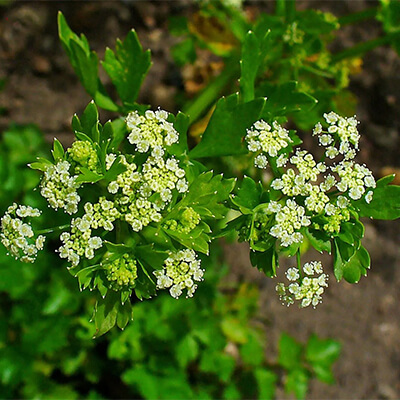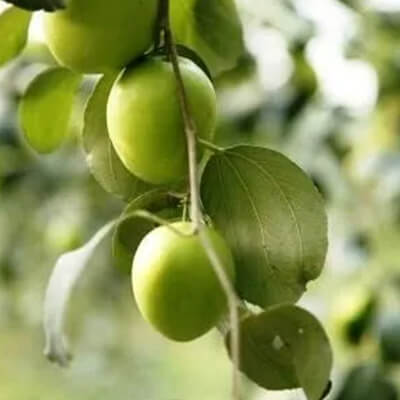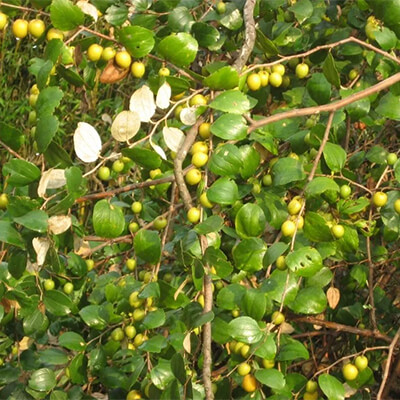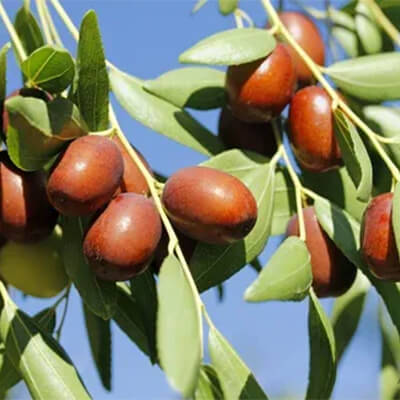On This Page
Ajamoda – The Excellent Carminative
Introduction
Ajamoda is a biennial or perennial plant, which is botanically known as Apium graveolens / Trachyspermum roxburghianum / Carum roxburghianum and belongs to the Apiaceae family. It is locally famous with the name Karaf’s and also well-known with the name celery. It is used in various disorders like hepatic disorder, spleen disorder, body aches, gastrointestinal disorder, brain disorders, etc. recent research has proved that Ajmoda exhibits anti-fungal, antihypertensive, hepato- protective, anti-cancerous, diuretic activity, etc.
As per Ayurvedic classical literature, Ajmoda is a herb that is Katu (pungent), Tikata (bitter), in taste with Ushana Virya (hot potency), and exhibits Kapha Vata Hara property. As per Ayurvedic classical texts, it is used in Agnimandya (low digestive fire), Shool (body aches), Hrid Roga (Cardiac disorders), Krimi Roga, etc.
Basonym of Ajamoda
अजं मोदयति तेन भक्ष्यमाण त्वात अजस्य मोदो गन्धो अस्त्यस्या इति वा।
The fruit of Ajamoda has a strong odor which may cause intoxication to goats if consumed. The fruit has a similar aroma to that of a goat.
Synonyms of Ajamoda
- According to properties and action
खराश्वा- खरैशयते इति। खर गंधी त्वातन्नमधेया।
The fruit of Ajamoda has a similar odor to the donkey.
दीप्यक: – अग्नि दीप्नि।
Ajamoda increases appetite.
उग्र गन्धिक: – उग्र: गन्धो अस्या इति।
Ajamoda has got a very strong aroma.
Regional Names of Ajamoda
- Celery (English)
- Ajamoda, Ajmada (Hindi)
- Voma (Kannada)
- Aayamodakam (Malayalam)
- Ajmoda Vova (Marathi)
- Ajmoda Vova (Gujarati)
- Randhuni (Bengali)
- Asmatavomam (Tamil)
- Ajamoda Vamu, Tella Vamu (Telugu)
- Fakhazur, Banjuan (Kashmiri)
- Bonjamani, Yamani, Ajowan, Bonajain (Assamese)
- Karafs- e- Hindi (Unani)
- Valjawain, Ajmod (Punjabi)
- Banajuani (Oriya)
Botanical Name
Apium graveolens Linn. or
Trachspermum roxburghianum Sprague.
Carum roxburghianum Benth. or
Carum means roots and seeds are edible, roxburghianum word is derived in memory of Dr. William Roxburgh a botanist.
The English name celery of Ajamoda is derived from the Italian word Soleri.
Family
Apiaceae (Shtapushpa Kula)
Ayurveda Reference for Ajmoda (Apium graveolens)

Scientific Classification of Ajamoda
| Kingdom | Plantae |
| Class | Dicotyledons |
| Subclass | Polypetalae |
| Series | Calyciflorae |
| Order | Umbellales |
| Family | Apiaceae |
| Genus | Carum |
| Species | Roxburghianum |
| Kingdom | Plantae |
| Subkingdom | Tracheobionta |
| Superdivision | Tracheophyta |
| Division | Magnoliopsida |
| Subclass | Rosidae |
| Order | Apiales |
| Family | Apiaceae |
| Genus | Apium |
| Species | Graveolens |
Classification of Ajamoda as per Charaka and Sushruta
- Charaka: Deepaniya Mahakshaya, Shool Prashmana Mahakshaya
- Sushruta: Pipplyadi Gana
Ajamoda’s Description in Brihtrayi
| Charaka | Shusruta | Vagbhata (Ashtang Hridya) |
| C. S. Su. 4/ 6, 45 | S. S. Su. 38/ 22 | A. H. Su. 15/ 33 |
| C. S. Su. 23/ 17 | S. S. Chi. 5/ 7, 28 | A. H. Chi. 5/ 28 |
| C. S. Su. 25/ 49 | S. S. Chi. 7/ 18 | A. H. Chi. 8/ 77 |
| C. S. Vi. 8/ 149, 158 | S. S. Chi. 8/ 17 | A. H. Chi. 11/ 29 |
| C. S. Chi. 3/ 266 | S. S. Chi. 14/ 10 | A. H. Chi. 14/ 35 |
| C. S. Chi. 5/ 79, 83, 87 | S. S. Chi. 37/ 16, 36, 41 | A. H. Ka. 4/ 64 |
| C. S. Chi. 11/ 87 | S. S. Ka. 5/ 63 | A. H. U. 2/ 12 |
| C. S. Chi. 12/ 41 | S. S. U. 36/ 7 | A. H. U. 34/ 30 |
| C. S. Chi. 14/ 74 | S. S. U. 40/ 80, 153 | |
| C. S. Chi. 15/ 95, 190 | S. S. U. 41/ 50 | |
| C. S. Chi. 30/ 53 | S. S. U. 42/ 42 | |
| C. S. Ka. 7/ 15 | S. S. U. 43/ 12 | |
| C. S. Ka. 15/ 40, 50 | S. S. U. 44/ 28 | |
| C. S. Si. 4/ 14 | S. S. U. 52/ 38 | |
| S. S. U. 53/ 11 | ||
| S. S. U. 56/ 17 | ||
| S. S. U. 62/ 28 |
Ajamoda’s Description in Brihtrayi as synonym Nirdahani
Sushruta Samhita: S. S. Chi. 4/ 32, S. S. U. 40/ 38, S. S. U. 44/ 28, S. S. U. 55/ 48 (Viniradahani), S. S. U. 57/ 10
Nirdahana, Nirdahani, and Vinirdahani may all be synonyms, but they have been interpreted differently as Agnimanth, Ajamoda, Chitraka, Morata, and Murva at different places by the same or different commentators. It may further be noted that only Sushruta has made use of these three names.
Ajamoda’s Description in Brihtrayi as synonym Dipyaka
| Charaka | Shusruta | Vagbhata (Ashtang Hridya) |
| C. S. Chi. 5/ 68 | S. S. Chi. 8/ 38 | A. H. Sa. 2/ 41 |
| C. S. Chi. 6/ 26, 37 | S. S. Chi. 15/ 20 | A. H. Chi. 1/ 139 |
| C. S. Chi. 9/ 60 | S. S. U. 40/ 42, 49 | A. H. Chi. 3/ 54, 144 |
| C. S. Chi. 12/ 38 | S. S. U. 42/ 25, 27, 32, 127 | A. H. Chi. 5/ 52 |
| C. S. Chi. 24/ 179 | S. S. U. 47/ 24 | A. H. Chi. 7/ 12 |
| S. S. U. 57/ 8 | A. H. Chi. 9/ 27, 111 | |
| A. H. Chi. 10/ 15 | ||
| A. H. Chi. 12/ 18 | ||
| A. H. Chi. 14/ 9, 11, 24, 31, 34, 37 | ||
| A. H. Chi. 21/ 59 | ||
| A. H. Ka. 2/ 18 | ||
| A. H. U. 1/ 49 | ||
| A. H. U. 2/ 10 | ||
| A. H. U. 3/ 47 | ||
| A. H. U. 34/ 64 |
Ajamoda’s Description in Brihtrayi as synonym Kharahva
Charaka Samhita: C. S. Su. 23/ 14, C. S. Su. 27/ 169, C. S. Chi. 14/ 44, C. S. Chi. 26/ 59, C. S. Si. 9/ 13
It has been identified with Ajamoda, Yavani, or Parsik Yavani.
Ajamoda’s Description in Brihtrayi as synonym Karvi
Charaka Samhita: C. S. Su. 27/ 302, C. S. Chi. 12/ 58, C. S. Chi. 13/ 124, C. S. Chi. 14/ 73, 90, 103, C. S. Chi. 24/ 180, C. S. Chi. 26/ 217
Sushruta Samhita: S. S. Su. 46/ 230
Vagbhata: A. H. Chi. 8/ 46, 50, A. H. Chi. 14/ 18, A. H. Chi. 15/ 14, A. H. Chi. 17/ 20
It is usually considered to be Carum carvi Linn. but it appears that it has been used as a name for other Apiaceae aromatic fruit such as Yavani, Ajmoda, Shatpushpa, etc. as well Karvi in C. S. Chi. 24/ 180 has been taken to be a type of grape (Draksha Vishesh), Gostanika.
Ajamoda’s Description in Brihtrayi as synonym Ugra
Sushruta Samhita: S. S. Chi. 25/ 38, S. S. Chi. 38/ 44, S. S. U. 23/ 4, S. S. U. 41/ 50, S. S. U. 51/ 27, S. S. U. 61/ 36
Vagbhata: A. H. Su. 8/ 15, A. H. Chi. 14/ 36, A. H. U. 1/ 45
Ugra and Ugragandha are usually considered a synonym of Vacha but sometimes Ajamoda is also accepted especially where digestive troubles are involved.
The historical background of Ajamoda
Herb Yavani and Ajamoda are often confused with others, but both are different herbs. It is important to note that Ajamoda is described with the synonyms like Yavanika, Dipyaka, and Brahmakusha while Yavani is described with synonyms like Ajamodika, Dipya, and Brahma Darbha. These references indicate that both these plants/ fruits of these plants are similar in appearance. The author who uses both these routinely experiences that Ajamoda is not as pungent as Yavani in taste. Like Yavani, Ajamoda is also used mainly as a carminative (Shoola Hara). It is used for the treatment of Krmi, Agnimandya, Ajirna, Chardi, Hikka, Vasti Vikara, etc. It is specifically quoted as Vrsya, Balya Hridya by the Nighantu writers. Ajamodarka is grandma’s recipe for the treatment of abdominal colic caused by indigestion and flatulence.
External morphology of Apium graveolens
- Habit: Ajamoda is a biennial or annual herb.
- Stems: stems of Ajamoda are 0.3 – 2.4 meters, erect and branching
- Leaves: Radical leaves are pinnate with large deeply lobed segments, Cauline tripartite, segment once or twice trifid. Leaf opposed. Lower leaves of Ajamoda are broad, whereas the upper leaves are linear-lanceolate.
- Inflorescence: Umbel inflorescence. White umbels have 5- 10 rays.
- Flowers: White or greenish-white and very small.
- Fruit: Very small, Cremocarp, 2 mm long, ridges narrow, vittae broad.
Flowering and fruiting time
Rainy to the autumn season.
Distribution of Ajamoda
Globally it is found in Afghanistan, Europe, West Asia, and North Africa. In India, it is distributed in the Hills of the Punjab and foot of the North-West Himalayas, cultivated in sub-Himalayan regions and outlying hills. Cultivated throughout India, especially in Maharashtra (Bombay) and other regions.
The useful part of Ajamoda
Fruits
Fruits of Ajamoda are ovoid or globular shaped, yellow or grayish-yellow in color, and up to 2 mm long. The surface is studded with blunt simple hair. The fruit consists of two mericarps, each having five ridges and fifteen vitae. Ajamoda fruit has a characteristic odor.
Important phytoconstituent of Ajamoda
- Seed: Anthoxanthins, graveobioside A and B, luteolin, apioseglycosider, myristicin acid, aprumetin umbelliferone, chrysoeriol.
- Essential oil: d-limonene, d-selinene, sesquiterpene alcohols, apigravin, sedanolide, and sedanomic acid anhydride.
- Leaves & tubers: Apiin, luteolin
Recent research on Ajamoda
- The essential oil was found to possess tranquilizing as well as anticonvulsant activities. When tested in rats (Kohli et al., 1967).
- The nitrogenous part of essential oil was found to have CNS activity. It protected the supramaximal seizure threshold test but was not effective against convulsions induced by Metrazol or strychnine. It was also found to have tranquilizing activity as it potentiated pentobarbital sleeping time. (Kulshresth et al., 1967).
- An alkaloidal fraction from the seeds also showed tranquilizing activity. The extract reduced mortality in aggregated mice by amphetamine (Kulshrestha et al., 1970).
- Both dialyzed and no-dialyzed solutions of aq. extract. on I. V. administration caused an abrupt decrease in B.P of rabbits and a significant increase in the force of contraction of isolated hearts of guinea pigs with no marked change in the rate of contraction. (Varasam Paeschasarthara 1977, 4, 10).
- 3-n-Butylphthalide and 3-n-buty1- 4, 5, -dihydro phthalide exhibited anticonvulsant activity (Yaoxue Tongbao 1984, 19, 670).
- A study was done to evaluate the chemical composition and antimicrobial activity of Trachyspermum roxburghianum. Studies have shown the presence of thymol, r- terpinene, and O- cymene were the major components of Trachyspermum roxburghianum. Thymol is an antimicrobial agent. Mahaboubi M & Kazempour N. Chemical composition and antimicrobial activity of Trachyspermum roxburghianum. Iran J. Microbial 2011 Dec; 3 (4): 194- 200.
- Abortifacient activity
- Anti-arthritic activity
- Anti-diabetic activity
- Diuretic activity
- Depurative activity
- Nervine activity
- Carminative
Rasa Panchaka of Ajamoda
| Rasa (Taste) | Katu (pungent), Tikata (Bitter) |
| Guna (Virtue) | Laghu (light), Ruksha (dry), Theekshana (sharp) |
| Virya (potency) | Ushana (hot potency) |
| Vipaka (post-digestion) | Katu (pungent) |
Dosha Karma of Ajamoda
Kapha – Vata Shamaka
Kapha Hara because of Katu Vipaka, Ushana Virya, and Katu, Tikata Rasa.
Vata Hara because of Ushana Virya.
Karma (Actions) of Ajamoda
Deepana, Shoolhara, Ruchikara, Vrishya, Hridya, Krimighana, Balya, Hikka Nigrehan, Basti Ruja Hara, Chardighana.
Prayogarha Vyadhi (Therapeutic indication) of Ajamoda
- Aruchi
- Shool
- Agnimandya
- Chardi
- Hridya Roga
- Hikka
- Basti Ruja
- Krimi Roga
Aamyik Paryog (Therapeutic uses) of Ajamoda
Atisara (Diarrhea and dysentery)
- Milk mixed with ghee, honey, and the powder of sugar, Ajamoda, Aralu, and Madhuka should be taken in case of diarrhea associated with pain. (Sushruta Samhita Uttara Tantra. 40/ 79).
- The formulation consisting of Patha, Ajamoda, Kutaja, Utpala, Sunthi, and Pippali all in equal quantity taken with tepid water controls the disease. (Sushruta Samhita Uttara Tantra. 40/ 154)
- Swara Bheda (Hoarseness of voice): Aja Ghrita (Goat’s clarified butter) processed with Yavaksara and Ajamoda or Chitraka and Amalaka or Devadaru and Ajamoda mixed with honey is useful in the disorder caused by Vata. (Sushruta Samhita Uttara Tantra. 53/ 11)
- Ashmari (Gravels): In the case of gravels (in urinary bladder) the following formulation is used- bones of deer, camel, and ass, Goksura, Talapatri, Ajamoda, and root (bark) of Kadamba and Bilva- all mixed are taken with wine or warm water. (Ashtanga Hridya Chikitsa Sthana. 11/ 28- 29)
- Agnimandya or Aruchi (Indigestion and loss of appetite): Ajamoda is one of the ingredients of the popular formulation ‘Hingvastaka Churna’. (Ashtanga Hridya Chikitsa Sthana. 14/ 35)
- Amavata (Rheumatoid arthritis): Ajamoda is the chief drug in “Ajamodadi Vataka” prescribed for Amavata. (Vrinda Madhava. 25. 36- 40)
- Stanya Shodhana (Impurity of breast- milk caused by Vata): The child should be given to lick ghee mixed or cooked with the powder of Ajamoda, Rasna, Sarala, and Devdaru along with sugar candy.
Benefits of Ajamoda
- Manifestation of chronic diseases like arthritis, heart disorders, etc (Jirna Vyadhi): Ajamoda consists of active principles like polyphenols, and flavonoid aero is caused due to free radicals. These free radicals if remain in the body result in inflammation which in turn results in the manifestation of various chronic diseases like arthritis, heart disorders, cancer, etc.
- High blood pressure (Uccha Rakta Chap): Ajamoda with its anti-hypertensive activity, helps to lower the blood pressure. In an Animal study of Ajamoda in rats, it was observed that Ajamoda seed extract lowers the blood pressure in hypertensive rats but has no effect on rats that have normal blood pressure.
- Mosquito repellent: Recent research has proved that a gel or paste product that contains Ajamoda extract of 5 to 25% can repel mosquitoes for up to 4.5 hours.
- Obesity/ weight loss (Medo Roga): Ajamoda with its antihyperlipidemic activity, significantly decreases the triglycerides, total serum cholesterol, and low-density lipoprotein cholesterol and along with this increases the high-density lipoprotein cholesterol levels. Ajamoda also helps to reduce lipid absorption in the intestine.
- Urinary tract infection: Ajamoda with its antimicrobial activity acts on various fungal and bacterial strains. Ajamoda inhibits the growth of various urinary bacterial pathogens like E. coli, L. monocytogenes, Campylobacter jejuni, Pseudomonas aeruginosa, etc. Therefore, Ajamoda helps with urinary tract infections.
- Gastro-intestinal diseases: Due to the phthalide constituents present in Ajamoda it helps to treat various gastrointestinal disorders like visceral spasms, abdominal pain, flatulence, etc. Ajamoda with its anti-inflammatory and anti-ulcer activity also helps to treat peptic ulcers.
Effect of Ajamoda on different systems of bodies
- Digestive system: Carminative, appetizer, analgesic, and anthelmintic. It is used in emesis, loss of appetite, hiccoughs, flatulence, stomachache, and helminthiasis.
- Circulatory system: It acts as a cardiac stimulant in cardiac disorders.
- Respiratory system: Due to its Kaphaghan property, it is used in cough (bronchitis), asthma, hiccough in the form of churn (powder), and also in the form of smoke (Dhoomapana). Its smoke gives quick relief to cough, hiccough, and asthma.
- Nervous system: The decoction of roots nourishes the brain and gives strength to nerves. But it is contraindicated in epilepsy.
- Urinary system: It is used when there is a pain in the urinary bladder, renal calculi, and urinary obstruction. It acts as a diuretic.
- Reproductive system: It is a uterine stimulant as well as an aphrodisiac. Therefore, it is used in amenorrhea, dysmenorrhea, and infertility. Though friendly to females, it should not be given in pregnancy.
- Satmikaran: It is bitter and nutritious. Therefore, used in general debility.
Matra (Therapeutic administration and dosage) of Ajamoda
- Churna (powder) – 1 to 5 grams
- Distillate – 0.25 to 0.5 ml

Have A Health Issue?
Consult Online
- Dr. Sahil Gupta (B.A.M.S., M.H.A.)
Ayurvedic Allergy Specialist
CEO & Founder of IAFA®
Classical reference of Ajamoda
Bhava Prakasha Nighantu Haritkyadi Varga- 77
Synonyms
अजमोदा खरारवा च मायूरो दीप्यकस्तथा |
तथा ब्रह्कुशा प्रोक्ता कारवीलोचमस्तका ||
Bhava Prakasha Nighantu Haritakyadi Varga- 78- 79
Properties and action
अजमोदा कटुस्तीक्षणा दीपनी कफ वातनुत् |
उष्णा विदाहिनी हद्या वृष्या बलकरी लघु: ||
नेत्रामय कृमि छर्दि हिक्का बस्ति रुजो हरेत ||
Dhanwantri Nighantu Shatpuspa Varga- 96
Properties and action
अजमोदा च शूलघ्नी तिक्तोष्णा कफ वातजित् |
हिक्काध्माना अरूचि हन्ति कृमिजिद वन्हिदीपनी ||
Kaiydeva Nighantu Aushadi Varga, 1201- 1203
अजमोदा कटुस्तिक्ता कटुपाका विदाहिनी |
दीपनी पाचनी रूक्षा विरयो उष्णा कफवातहा ।
लघुस्तिक्ता बद्धविट्का हद्या वृष्या विनाश्येत |
नेत्ररोगा अरूचि छर्दि आध्मान वस्ति रुक कृमीन ||
Raja Nighantu Pipalyadi Varga, 110
अजमोदा कटुरूष्णा रूक्षा कफ वातहारिणी रुचि कृत् |
शूलाध्मानारोचक जठरामयनाशनी चैव ||
Priya Nighantu, Shatpusphadi Varga, 13
अजमोदा मता वैद्ये: यवानी सदृश गुणैः |
कफ वात विकारेषु बहि: सम्मार्जने हिता ||
Charaka Samhita Sutra Sthana, 27/ 172
खराहा कफवातघ्नी बस्ति रोग रुजापहा |
Dhanwantri Nighantu Shatpuspa Varga, 95
अजमोदा बस्तमोदा दीप्यको लोचकर्कट: | खरावह कारवी वल्ली मोदा हस्तिमयूरक: ||
Shodhala Nighantu
मोदा अजमोदा च दीप्यका चैव मर्कटी |
खरावहा कारवी वल्ली तथा हस्तिमयूरक: ||
ब्रह्मकोशोग्रगंधा च हद्यगंधा प्रकीर्तिता ||
दीपनो भेदनो अस्थ्यादि द्रावणश्च अग्निमांद्य जित् । खराश्चा कफवातघ्नी बस्तिरोगरुजापहा ||
अजमोदा खरावः च बस्ति मोदा च मर्कटी |
Raja Nighantu Pipalyadi Varga, 109
मोदा गन्धदला हस्तिकारवी गन्थपत्रिका ||
मायूरी शिखी मोदा च मोदा आद्या वह्नि दीपिका । ब्रह्मकोशी विशाली च हद्यगन्धोग्रगन्धिका ॥
मोदनी फलमुख्या च विंशत्याख्यासुवाचिका ।
Shusruta Samhita Uttara Tantra. 40/ 79
सशूले अतिसार
पयो घृतञ्च मधु च पिबेच्छूलैरभिद्रुत: |
सिताजमोद कट्वंग मधुकैरव चूर्णितम् ||
Shusruta Samhita Uttara Tantra. 40/ 154
प्रवाहिका
पाठा अजमोदा कुटजोत्पलञ्च शुण्ठी समा मागधिकाञ्च पिष्ठा: ।
सुखाम्बुपीता: शमयन्ति रोगम |
Shusruta Samhita Uttara Tantra. 53/ 11
वातजे स्वरभेदे
यव् क्षाराजमोदाभ्यां चित्रकामलकेषु वा।
देवदार्वग्निकाभ्यां वा सिद्धमाजं समाक्षिकम् ||
Ashtanga Hridya Chikitsa Sthana. 11/ 28- 29
शर्करायाम
क्रौज्ञोष्ट्रासभास्थीनि श्वदष्ट्रा तालपत्रिका।
अजमोदा कदम्बस्य मूलं बिल्वस्य चौषधम् ||
पीतानि शर्करा: भिन्द्यौ: सुरयोष्णोदकेन वा |
Charaka Samhita Sutra Sthana. 27/ 172
खराह्वा कफवातघ्नी बस्ति रोग रुजापहा |
Charaka Samhita Sutra Sthana. 4/ 9
अग्नि दीपनार्थ
दीपनीयमहाकषाये |
Ashtanga Hridya Chikitsa Sthana. 11/ 28- 29
हिंग्वाष्टक चूर्ण |
Vrinda Madhava. 25/ 36- 40
आमवाते
अजमोदादिवटक: |
Charaka Samhita Sutra Sthana. 4/ 17
शूले
शूलप्रशमनगणे
Ashtanga Hridya Uttara Tantra. 2/ 12
वातदुष्टे स्तन्ये
रास्ना अजमोदा सरल देवदारु रजो:न्वितम् |
बालो लिह्याद घृतम तैर्वा विपक्वं ससितोपलम् ||
Specific Formulation of Ajamoda
- Ajamodadi Kwatha for Chathurthika Jwara
- Ajamodadi churna for Atisaara and Shoola
- Hingwastaka Churna for Agnimandya, Vata Vyadhi
- Ajamoda Aadraka
- Ajamodadi Vataka
Contraindication and side effects of Ajamoda
- Ajamoda is likely safe if taken orally in food amounts. An Ajamoda has anti-hypertensive activity, so if taking Ajamoda as medicine, take it under medical supervision because it may lower blood pressure and also may cause sleepiness.
- Avoid the use of Ajamoda during pregnancy and breastfeeding as Ajamoda in a large dosage may cause uterine contractions and may result in miscarriage.
- Ajamoda also increases the risk of bleeding so if you are suffering from a bleeding disorder avoid the use of Ajamoda.
Suggestive Readings
- Al-Asmari, A. K., Athar, M. T., & Kadasah, S. G. (2017). An Updated Phytopharmacological Review on Medicinal Plant of Arab Region: Apium graveolens Linn. Pharmacognosy Reviews, 11 (21), 13– 18. https:// doi. org/ 10.4103/ prev. phrev_ 35_ 16.
- Nagella P, Ahmad A, Kim SJ, Chung IM. Chemical composition, antioxidant activity, and larvicidal effects of essential oil from leaves of Apium graveolens. Immunopharmacol Immunotoxicol. 2012; 34: 205– 9.
- Khole S, Panat NA, Suryawanshi P, Chatterjee S, Devasagayam T, Ghaskadbi S. Comprehensive Assessment of Antioxidant Activities of Apigenin Isomers: Vitexin and Isovitexin. Free Radicals & Antioxidants.
- Asif, Muhammad & Akram, Muhammad & Usmanghani, Khan & Naveed, Akhtar & Shah, Pervaiz & Uzair, Muhmmad & Ramzan, Memona & Ali Shah, Dr. Syed & Riaz Ur Rehman, Muhammad. (2011). Monograph of Apium graveolens Linn. Journal of Medicinal Plants Research. 5. 1494- 1496.
- Jung, W.S.; Chung, I.M.; Kim, S.H.; Kim, M.Y.; Ahmad, A.; Praveen, N. In vitro antioxidant activity, total phenolics and flavonoids from celery (Apium graveolens) leaves. J. Med. Plant. Res.2011. 5 (32): 7022- 7030.
- Gijbels, Phthalides in roots of Apium graveolens, A. graveolen svarrapaceum, Biforate sticulata and Petro selinum crispum va rtuberosum, Fitoterapia, 1985. 56: 17- 23.
- Choochote W, Tuetun B, Kanjanapothi D, Rattanachanpichai E, Chaithong U, Chaiwong P, Jitpakdi A, Tippawangkosol P, Riyong D, Pitasawat B. Potential of crude seed extract of celery, Apium graveolens L., against the mosquito Aedes aegypti (L.) (Diptera: Culicidae). J Vector Ecol. 2004. 29 (2): 340- 6.
- Singh A, Handa SS (1995). Hepatoprotective activity of Apium graveolens and Hygrophila auriculata against paracetamol and thioacetamide intoxication in rats. J. Ethnopharmacol., 49 (3): 119- 126
- Teng CM, Lee LG, Ko SN (1985). Inhibition of platelet aggregation by apigenin from Apium graveolens. As. Pac. J. Pharmacol., 83: 85. the healing potential of medicinal plants, based on a rational analysis of an ethnopharmacological field survey among Bedouins in the Negev desert. Israel. J. Ethnopharmacol., 16: 275- 278.
- Monica, Sarah & Diana, (2021). Medicinal properties of celery seeds (Apium graveolens L.). Advances in Bioresearch. 12. 252- 257. 10. 15515/abr. 0976-4585. 12. 1. 252257.
- Tashakori-Sabzevar, F., Ramezani, M., Hosseinzadeh, H. Seyyed, M., Reza, P., Ahmad, R.M. et al. (2016). Protective and hypoglycemic effects of celery seed on streptozotocin-induced diabetic rats: experimental and histopathological evaluation. Acta. Diabetol., 53: 609– 619.
References
- Agnivesha, Charaka, Dridhabala. In: Charaka Samhita, ed. Vaidya Jadavaji Trikamji Aacharya., editor. Varanasi: Chaukhamba Sanskrit Sansthan; 2009.
- Sushruta. In: Sushruta Samhita, Sutra Sthana, ed. Vaidya Jadavji Trikamji Acharya., editor. Varanasi: Choukhambha Orientalia; 2005.
- Vagbhata. In: Ashtanga Hrudaya, 9th ed. Anna Moreshwar Kunte, Krishnashastri Navarre, Harishastri, editors. Varanasi: Choukhambha Orientalia; 2005.
- Bhavamishra. In: Bhava Prakasha Nighantu, Haritkyadi Varga, 11th ed. part 2. Brahma Shankara Mishra., editor. Varanasi: Choukhambha Bharati Academy; 2009.
- Bhavprakasha, commentary by Bulusu Sitaram, forwarded by K.C.Chunekar
- Sharma PV, Kaideva Nighantu. Aushadhi Varga. Chaukhamba Orientalia, Varanasi; 2006:
- Tripathi I., Raja Nighantu, Piplyadi Varga, Chaukhamba Krishnadas Academy; Varanasi; 2010
- P.V. Sharma, Priya Nighantu, Shatpushpadi Varga, Chaukhamba Krishnadas Academy; Varanasi.
- Dhanwantri Nighantu, Shatpushpadi Varga, Chaukhamba Krishnadas Academy; Varanasi.
- Shodhala Nighantu, Chaukhamba Krishnadas Academy; Varanasi.
- Dr. Gyanendra Pandey, Dravyaguna Vigyana, reprint 2012, Chawkhamba Krishnadas Academy
- K. Niteshwar Dravyaguna Vigyan, reprint 2017.
- Dr. J.L.N. Sastry and Dr. B.S. Sastry, Dravyaguna Vigyana, Chaukhambha Orientalia, Varanasi.
Ayurveda is an Indian system of medicine that is popular since ancient times. Dr. Gupta’s IAFA® has been conducting research studies to find out different phytoconstituents of herbs and their action in the body. Such knowledge acquired by our experts is used in the preparation of medicines and providing the treatment facilities safely and effectively. IAFA® is the provider of safe and effective treatment for a wide range of diseases, mainly allergic diseases all based on Ayurveda.











